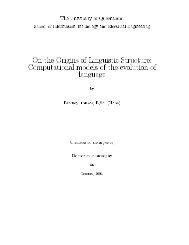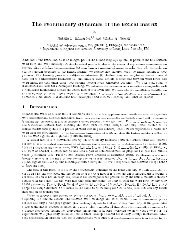Planning and Managing an Exhibition Programme
Planning and Managing an Exhibition Programme
Planning and Managing an Exhibition Programme
You also want an ePaper? Increase the reach of your titles
YUMPU automatically turns print PDFs into web optimized ePapers that Google loves.
iloNs<br />
uate numbers<br />
:ollection may<br />
)ngtemporary<br />
:ions, such as<br />
,llection, have<br />
ritions are the<br />
r among those<br />
cn of cultural<br />
he community<br />
rority museum<br />
that museum's<br />
exhibitions of<br />
le to them. An<br />
n programme,<br />
vs to be drawn<br />
r this 'window<br />
o<br />
o<br />
o<br />
A temporary exhibition may consist of a new presentation of the museum's<br />
perm<strong>an</strong>ent collection. In recent years the Tate Gallery (now in rwo London<br />
locations, Tate Britain <strong><strong>an</strong>d</strong> Tate Modern) has shown the potential of <strong>an</strong> <strong>an</strong>nual<br />
'reh<strong>an</strong>g' of its collection, complete with opening receptions <strong><strong>an</strong>d</strong> reviews.<br />
A museum's potential for such a programme depends on the r<strong>an</strong>ge <strong><strong>an</strong>d</strong> depth of<br />
its perm<strong>an</strong>ent collection.<br />
The museum may borrow works related to objects in its collections, <strong><strong>an</strong>d</strong> present<br />
them together as a thematically related show. The National Gallery's Fighting<br />
Temeraire exhibition in London, described in case study 10.1, provides <strong>an</strong> excellent<br />
example of a series of National Gallery shows in which a major painting in the<br />
collection is placed in a context supported by lo<strong>an</strong>s from other institutions <strong><strong>an</strong>d</strong><br />
individuals. The result enriches the museum's underst<strong><strong>an</strong>d</strong>ing of its own collection<br />
as well as attracting renewed public interest in specific works of art or artefacts.<br />
The museum may choose a subject or theme <strong><strong>an</strong>d</strong> borrow objects from m<strong>an</strong>y<br />
sources, possibly including only a few items from its own collections. <strong>Exhibition</strong>s<br />
that document <strong>an</strong> artist's entire oeuure, a whole civilisation, or all aspects of a<br />
species such as dinosaurs or whales, are among the m<strong>an</strong>y examples of this type of<br />
exhibition. Science centres may rely less on borrowing <strong><strong>an</strong>d</strong> more on fabrication of<br />
new exhibit apparatus to explore such subjects as chemistrS physics or astronomy.<br />
x a hunsthalle<br />
t a site-specific<br />
,ondon's Freud<br />
contemporary<br />
subject matter.<br />
iry sometimes<br />
engaged guest<br />
eal with other<br />
may be useful<br />
asking 'Is this<br />
cfficer, or have<br />
'ary exhibition<br />
n<strong>an</strong>aging both<br />
possible levels<br />
rry exhibitions:<br />
o Although the preceding three levels of engagement are applicable to shows<br />
originated by the exhibiting institution, museums c<strong>an</strong> also participate in lo<strong>an</strong><br />
exhibitions initiated by others. Participation may be limited to paying a fee, or may<br />
involve collaboration in research, preparation of catalogues, negotiation of lo<strong>an</strong>s,<br />
or other services.<br />
o Finally, museums may simply receive <strong><strong>an</strong>d</strong> display 'package shows', exhibitions<br />
circulated by specialised agencies such as the Americ<strong>an</strong> Federation of Arts or the<br />
Smithsoni<strong>an</strong> Institution Temporary <strong>Exhibition</strong> Service (SITES). For such<br />
exhibitions the receiving institution usually pays a fee <strong><strong>an</strong>d</strong> receives a completely<br />
prepared exhibition, including a fixed number of catalogues, posters, publicity<br />
photographs, <strong><strong>an</strong>d</strong> the text of a news release.<br />
Most 'package shows' are relatively small, since they are designed for circulation to a<br />
relatively large number of possible venues. The opposite extreme is the blockbuster,<br />
usually a relatively large exhibition for which there is known to be a broad public<br />
interest, <strong><strong>an</strong>d</strong> for which there is a very limited distribution. Major exhibitions of the<br />
French Impressionist artists, V<strong>an</strong> Gogh, or <strong>an</strong>cient Egypt are almost always<br />
PLANNINGANDMANAGINGANEXHIBITIONPROGRAMME 277







